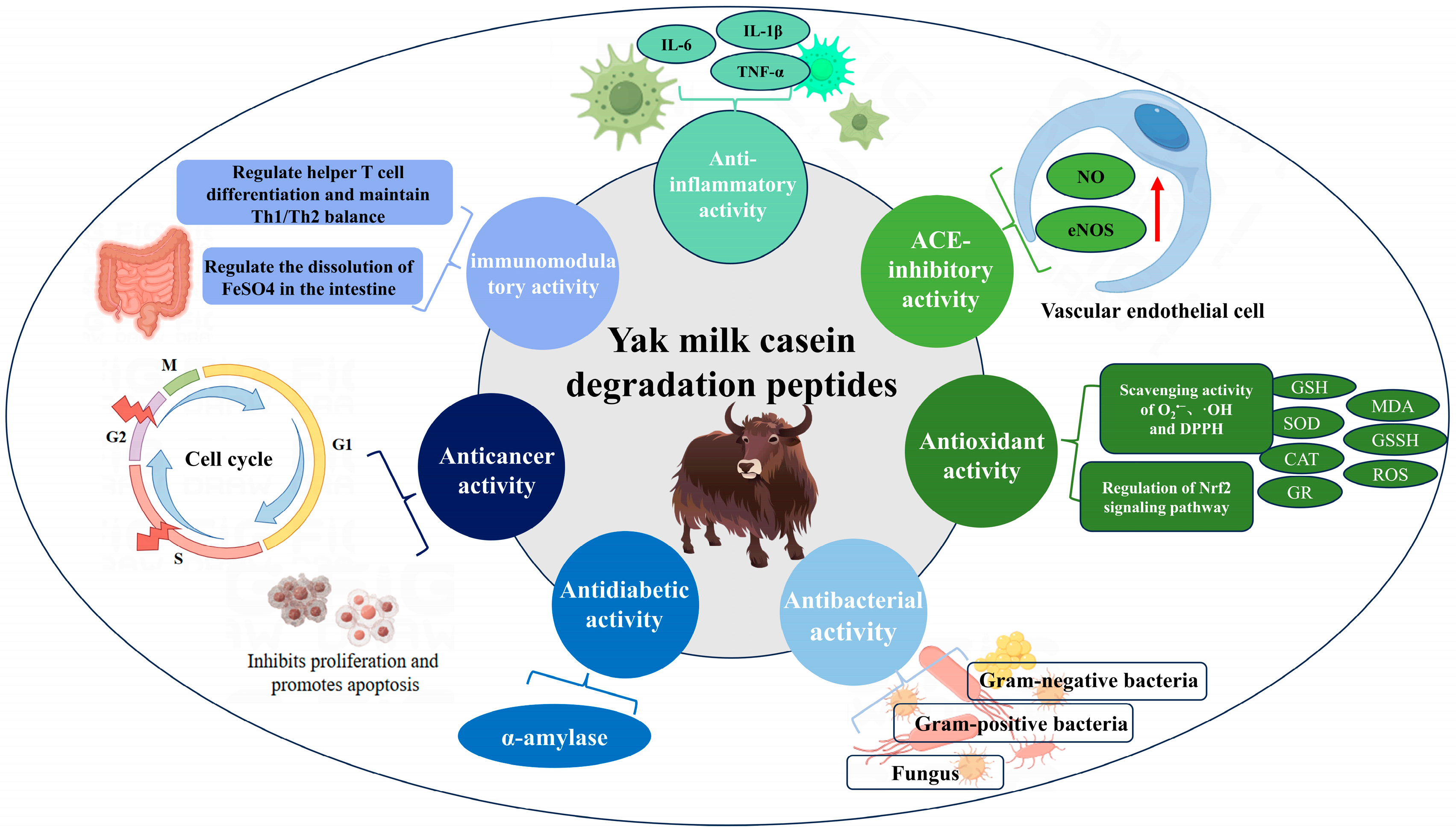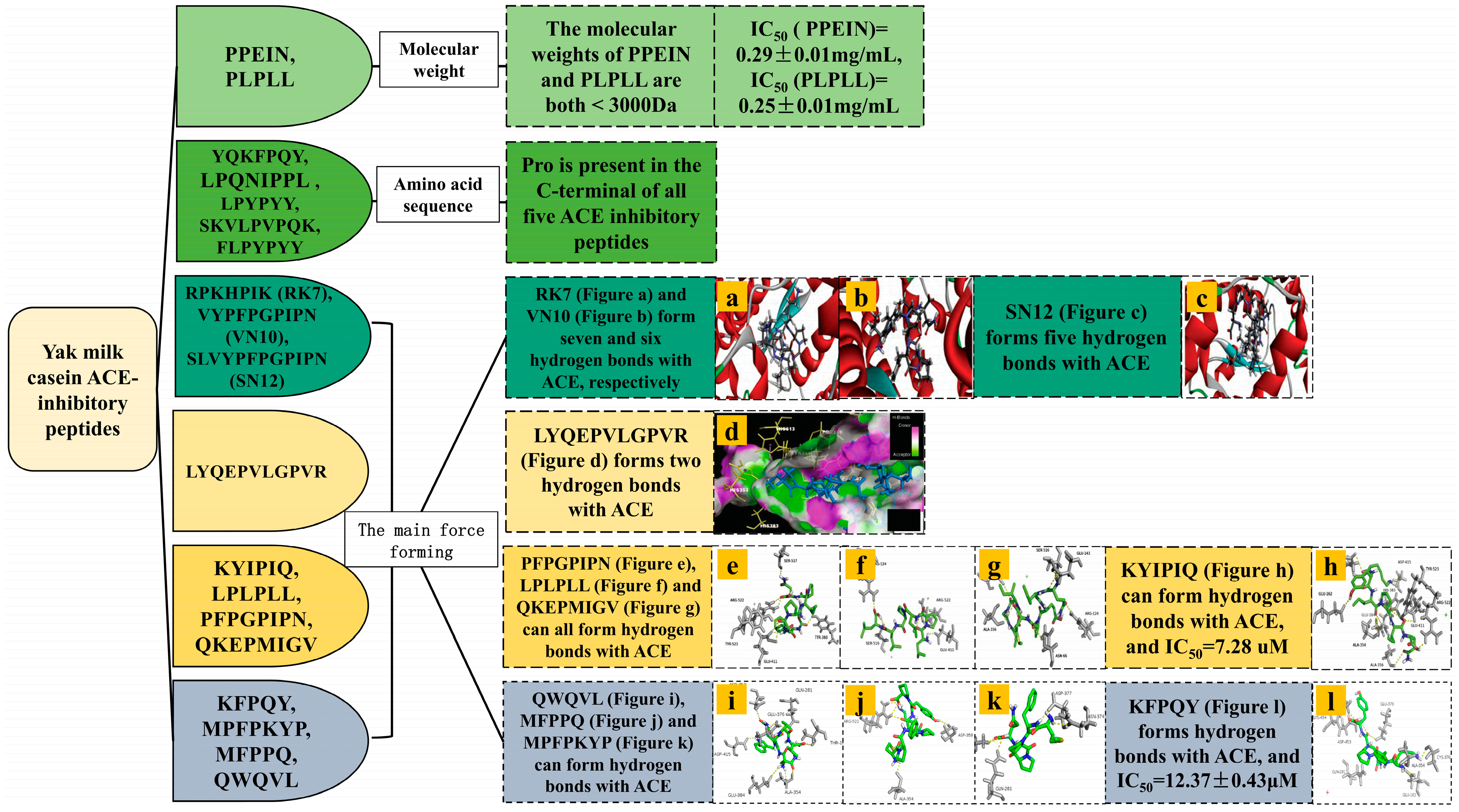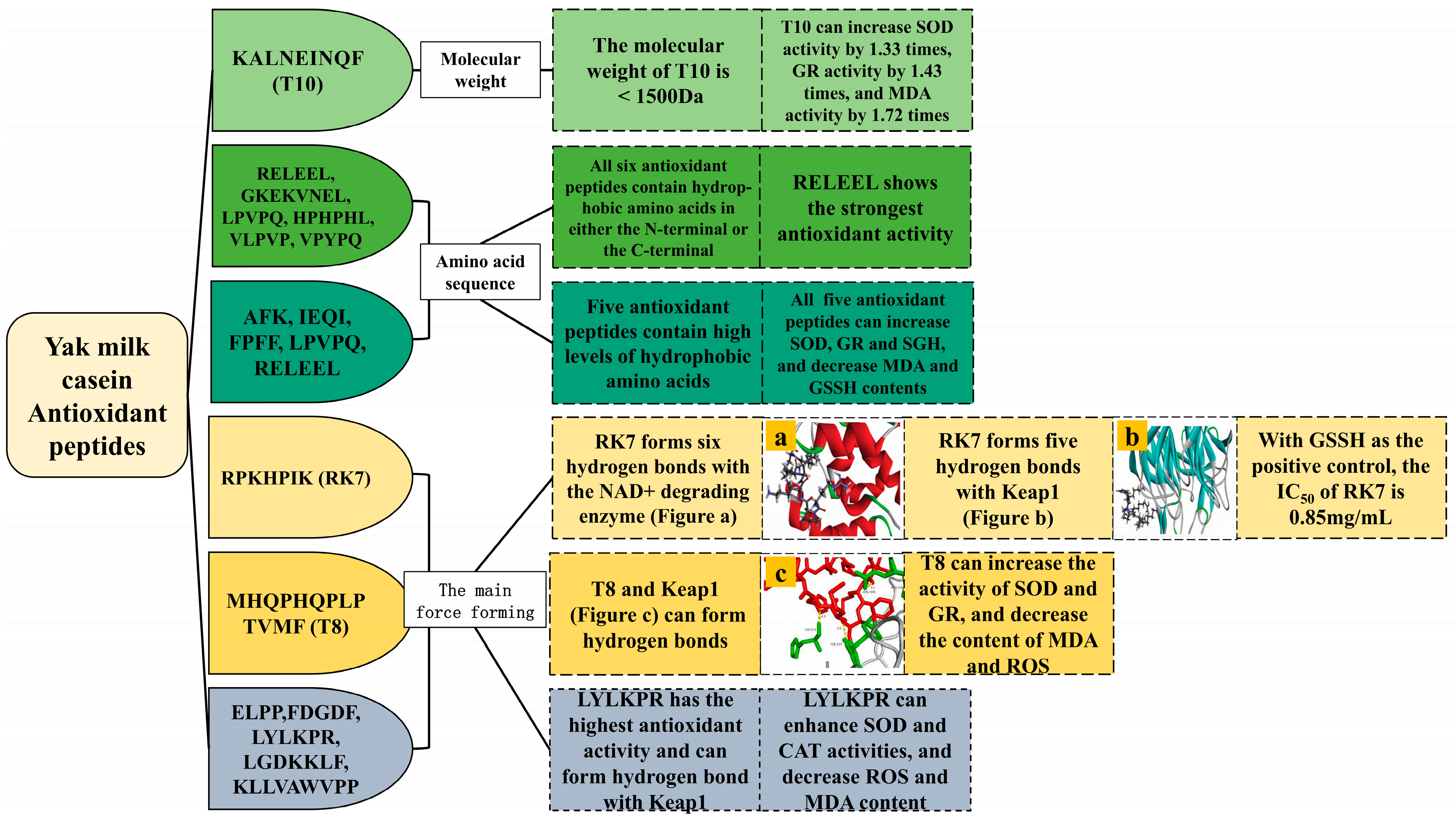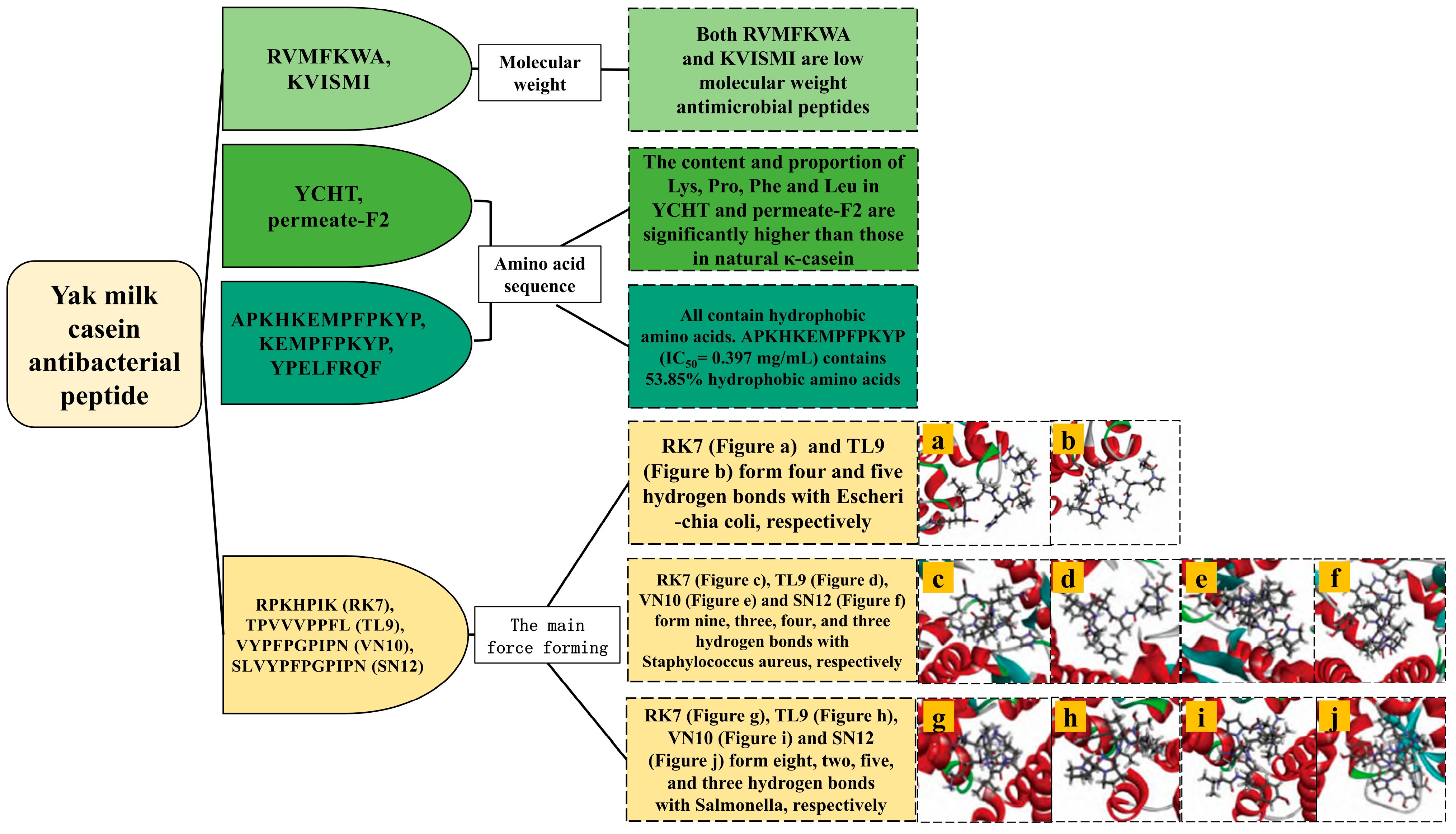Functional Peptides from Yak Milk Casein: Biological Activities and Structural Characteristics
Abstract
:1. Introduction
2. Types and Contents of Proteins in Yak Milk
3. Functional Activities of Degraded Peptides from Different Milk Sources
4. Functional Activity and Structural Characterization of Yak Milk Casein Degradation Peptides
4.1. Structure–Activity Relationship of ACE-Inhibitory Peptides
4.2. Structure-Activity Relationship of Antioxidant Peptides
4.3. Structure–Activity Relationship of Anti-Inflammatory Peptides
4.4. Structure–Activity Relationship of Antidiabetic Compounds
4.5. Structure–Activity Relationship of Antibacterial Peptides
4.6. Structure–Activity Relationship of Anticancer Peptides
4.7. Structure–Activity Relationship of Immunomodulatory Peptides
5. Conclusions and Prospects
Author Contributions
Funding
Conflicts of Interest
References
- Daliri, E.B.; Oh, D.H.; Lee, B.H. Bioactive Peptides. Foods 2017, 6, 32. [Google Scholar] [CrossRef]
- Yang, B.J.; Liang, Q.; Song, X.M. A Study on Difference of Antibacterial Activity of Bitter Peptide from Yak Milk Hard Cheese Based on Computer Virtual Technology. J. Food Sci. Biotechnol. 2021, 40, 75–87. [Google Scholar]
- Jiang, X.X.; Pan, D.D.; Zhang, T.; Liu, C.; Zhang, J.X.; Su, M.; Wu, Z.; Zeng, X.Q.; Sun, Y.Y.; Guo, Y.X. Novel milk casein-derived peptides decrease cholesterol micellar solubility and cholesterol intestinal absorption in Caco-2 cells. J. Dairy Sci. 2020, 103, 3924–3936. [Google Scholar] [CrossRef] [PubMed]
- Zhang, Y.; Chen, R.; Ma, H.; Chen, S. Isolation and Identification of Dipeptidyl Peptidase IV-Inhibitory Peptides from Trypsin/Chymotrypsin-Treated Goat Milk Casein Hydrolysates by 2D-TLC and LC-MS/MS. J. Agric. Food Chem. 2015, 63, 8819–8828. [Google Scholar] [CrossRef] [PubMed]
- Silva, S.V.; Pihlanto, A.; Malcata, F.X. Bioactive peptides in ovine and caprine cheeselike systems prepared with proteases from Cynara cardunculus. J. Dairy Sci. 2006, 89, 3336–3344. [Google Scholar] [CrossRef] [PubMed]
- Sowmya, K.; Bhat, M.I.; Bajaj, R.; Kapila, S.; Kapila, R. Antioxidative and anti-inflammatory potential with trans-epithelial transport of a buffalo casein-derived hexapeptide (YFYPQL). Food Biosci. 2019, 28, 151–163. [Google Scholar] [CrossRef]
- Shuang, Q.; Harutoshi, T.; Taku, M. Angiotension-I-converting enzyme inhibitory peptide inskim milk fermented with Lactobacillus helveticus 130B4 from camel milk in Inner Mongolia, China. J. Sci. Food Agric. 2008, 88, 2688–2692. [Google Scholar]
- Chen, Y.; Wang, Z.; Chen, X.; Liu, Y.; Zhang, H.; Sun, T. Identification of angiotensin I-converting enzyme inhibitory peptides from koumiss, a traditional fermented mare’s milk. J. Dairy Sci. 2010, 93, 884–892. [Google Scholar] [CrossRef]
- Beltrán-Barrientos, L.M.; García, H.S.; Torres-Llanez, M.J.; González-Córdova, A.F.; Hernández-Mendoza, A.; Vallejo-Cordoba, B. Safety of milk-derived bioactive peptides. Int. J. Dairy Technol. 2016, 70, 16–22. [Google Scholar] [CrossRef]
- Yang, B.J.; Liang, Q.; Song, X.M. Molecular Mechanism of ACE Inhibitory Activity Characterization of Yak Milk Cheese Bitter Peptide. J. Chin. Inst. Food Sci. Technol. 2022, 22, 8–17. [Google Scholar]
- Singh, T.P.; Arora, S.; Sarkar, M. Yak milk and milk products: Functional, bioactive constituents and therapeutic potential. Int. Dairy J. 2023, 142, 105637. [Google Scholar] [CrossRef]
- Wang, D.D.; Zhou, Y.X.; Zheng, X.P.; Guo, J.H.; Duan, H.; Zhou, S.Q.; Yan, W.J. Yak Milk: Nutritional Value, Functional Activity, and Current Applications. Foods 2023, 12, 2090. [Google Scholar] [CrossRef]
- Li, M.Y.; Liang, Q.; Song, X.M. Using molecular docking to investigate the alpha-amylase inhibitory activity of bitter peptides RK7 and KQ7 derived from yak cheese. Food Sci. 2023, 44, 132–138. [Google Scholar]
- Samtiya, M.; Samtiya, S.; Badgujar, P.C.; Puniya, A.K.; Dhewa, T.; Aluko, R.E. Health-Promoting and Therapeutic Attributes of Milk-Derived Bioactive Peptides. Nutrients 2022, 14, 3001. [Google Scholar] [CrossRef]
- Mahlapuu, M.; Håkansson, J.; Ringstad, L.; Björn, C. Antimicrobial Peptides: An Emerging Category of Therapeutic Agents. Front. Cell. Infect. Microbiol. 2016, 6, 194. [Google Scholar] [CrossRef]
- Yang, B.J.; Liang, Q. Advances on the structure-activity relationship of bioactive peptides in cheese. Food Ferment. Ind. 2021, 47, 288–293. [Google Scholar]
- Li, A.L.; Liu, C.; Han, X.T.; Zheng, J.; Zhang, G.F.; Qi, X.X.; Du, P.; Liu, L.B. Tibetan Plateau yak milk: A comprehensive review of nutritional values, health benefits, and processing technology. Food Chem. X 2023, 20, 100919. [Google Scholar] [CrossRef]
- El-Salam, M.H.A.; El-Shibiny, S. Bioactive Peptides of Buffalo, Camel, Goat, Sheep, Mare, and Yak Milks and Milk Products. Food Rev. Int. 2013, 29, 1–23. [Google Scholar] [CrossRef]
- Li, H.M.; Ma, Y.; Li, Q.M.; Wang, J.Q.; Cheng, J.J.; Xue, J.; Shi, J. The chemical composition and nitrogen distribution of Chinese yak (Maiwa) milk. Int. J. Mol. Sci. 2011, 12, 4885–4895. [Google Scholar] [CrossRef]
- Claeys, W.L.; Verraes, C.; Cardoen, S.; De Block, J.; Huyghebaert, A.; Raes, K.; Dewettinck, K.; Herman, L. Consumption of raw or heated milk from different species: An evaluation of the nutritional and potential health benefits. Food Control 2014, 42, 188–201. [Google Scholar] [CrossRef]
- Ma, Z.L.; Gan, B.Z.; Qiao, H.J.; Liang, Q.; Zhang, W.B.; Mi, L. The influence of different parities and lactation monthson the nutrient contents of black yak milk from Gannan. J. Gansu Agric. Univ. 2011, 46, 6–10. [Google Scholar]
- Upadhyay, D.; Kaur, T.; Kapila, R.; Kapila, S. Repertoire of Structure-Activity-Based Novel Modified Peptides Elicits Enhanced Osteogenic Potential. J. Agric. Food Chem. 2020, 68, 8308–8320. [Google Scholar] [CrossRef]
- Abdel-Hamid, M.; Romeih, E.; Saporito, P.; Osman, A.; Mateiu, R.V.; Mojsoska, B.; Jenssen, H. Camel milk whey hydrolysate inhibits growth and biofilm formation of Pseudomonas aeruginosa PAO1 and methicillin-resistant Staphylococcus aureus. Food Control 2020, 111, 107056. [Google Scholar] [CrossRef]
- Suetsuna, K.; Ukeda, H.; Ochi, H. Isolation and characterization of free radical scavenging activities peptides derived from casein. J. Nutr. Biochem. 2000, 11, 128–131. [Google Scholar] [CrossRef]
- Chakrabarti, S.; Liao, W.; Davidge, S.T.; Wu, J.P. Milk-derived tripeptides IPP (Ile-Pro-Pro) and VPP (Val-Pro-Pro) differentially modulate angiotensin II effects on vascular smooth muscle cells. J. Funct. Foods 2017, 30, 151–158. [Google Scholar] [CrossRef]
- Rafiq, S.; Huma, N.; Rakariyatham, K.; Hussain, I.; Gulzar, N.; Hayat, I. Anti-inflammatory and anticancer activities of water-soluble peptide extracts of buffalo and cow milk Cheddar cheeses. Int. J. Dairy Technol. 2017, 71, 432–438. [Google Scholar] [CrossRef]
- Kashyap, R.; Narayan, S.K.; Vij, S. Identification of antibacterial and immunomodulatory bioactive peptides generated from buffalo (Bubalus bubalis) colostrum whey fermented by Lactobacillus rhamnosus C25: LC-MS/MS-based analysis. J. Funct. Foods 2022, 95, 105158. [Google Scholar] [CrossRef]
- Lin, K.; Ma, Z.; Ramachandran, M.; De Souza, C.; Han, X.; Zhang, L.W. ACE inhibitory peptide KYIPIQ derived from yak milk casein induces nitric oxide production in HUVECs and diffuses via a transcellular mechanism in Caco-2 monolayers. Process Biochem. 2020, 99, 103–111. [Google Scholar] [CrossRef]
- Mao, X.Y.; Cheng, X.; Wang, X.; Wu, S.J. Free-radical-scavenging and anti-inflammatory effect of yak milk casein before and after enzymatic hydrolysis. Food Chem. 2011, 126, 484–490. [Google Scholar] [CrossRef]
- Gu, H.F.; Liang, L.; Zhu, Z.W.; Mao, X.Y. Preparation and identification of anti-breast cancer cells peptides released from yak milk casein. Front. Nutr. 2022, 9, 997514. [Google Scholar] [CrossRef]
- Bader, M. Tissue renin-angiotensin-aldosterone systems: Targets for pharmacological therapy. Annu. Rev. Pharmacol. Toxicol. 2010, 50, 439–465. [Google Scholar] [CrossRef]
- Xue, L.; Yin, R.X.; Howell, K.; Zhang, P.Z. Activity and bioavailability of food protein-derived angiotensin-I-converting enzyme-inhibitory peptides. Comprehensive Rev. Food Sci. Food Saf. 2021, 20, 1150–1187. [Google Scholar] [CrossRef]
- Mao, X.Y.; Ni, J.R.; Sun, W.L.; Hao, P.P.; Li, F. Value-added utilization of yak milk casein for the production of angiotensin-I-converting enzyme inhibitory peptides. Food Chem. 2007, 103, 1282–1287. [Google Scholar] [CrossRef]
- Jiang, J.L.; Chen, S.W.; Ren, F.Z.; Luo, Z.; Zeng, S.S. Yak milk casein as a functional ingredient: Preparation and identification of angiotensin-I-converting enzyme inhibitory peptides. J. Dairy Res. 2007, 74, 18–25. [Google Scholar] [CrossRef]
- Abedin, M.M.; Chourasia, R.; Chiring Phukon, L.; Singh, S.P.; Kumar Rai, A. Characterization of ACE inhibitory and antioxidant peptides in yak and cow milk hard chhurpi cheese of the Sikkim Himalayan region. Food Chem. X 2022, 13, 100231. [Google Scholar] [CrossRef]
- Lin, K.; Zhang, L.W.; Han, X.; Cheng, D.Y. Novel angiotensin I-converting enzyme inhibitory peptides from protease hydrolysates of Qula casein: Quantitative structure-activity relationship modeling and molecular docking study. J. Funct. Foods 2017, 32, 266–277. [Google Scholar] [CrossRef]
- Lin, K.; Zhang, L.W.; Han, X.; Meng, Z.X.; Wu, Y.F.; Zhang, J.M.; Cheng, D.Y. Quantitative Structure-Activity Relationship Modeling Coupled with Molecular Docking Analysis in Screening of Angiotensin I-Converting Enzyme Inhibitory Peptides from Qula Casein Hydrolysates Obtained by Two-Enzyme Combination Hydrolysis. J. Agric. Food Chem. 2018, 66, 3221–3228. [Google Scholar] [CrossRef]
- Lin, K.; Zhang, L.W.; Han, X.; Xin, L.; Meng, Z.X.; Gong, P.M.; Cheng, D.Y. Yak milk casein as potential precursor of angiotensin I-converting enzyme inhibitory peptides based on in silico proteolysis. Food Chem. 2018, 15, 340–347. [Google Scholar] [CrossRef]
- Ma, M.; Bae, I.; Lee, H.; Yang, C. Purification and identification of angiotensin I-converting enzyme inhibitory peptide from buckwheat. Food Chem. 2006, 96, 36–42. [Google Scholar] [CrossRef]
- Li, X.Y.; Feng, C.S.; Hong, H.; Zhang, Y.; Luo, Z.G.; Wang, Q.Y.; Luo, Y.K.; Tian, Y.Q. Novel ACE inhibitory peptides derived from whey protein hydrolysates: Identification and molecular docking analysis. Food Biosci. 2022, 48, 101737. [Google Scholar] [CrossRef]
- Baba, W.N.; Baby, B.; Mudgil, P.; Gan, C.Y.; Vijayan, R.; Maqsood, S. Pepsin generated camel whey protein hydrolysates with potential antihypertensive properties: Identification and molecular docking of antihypertensive peptides. LWT Food Sci. Technol. 2021, 143, 111135. [Google Scholar] [CrossRef]
- Chamata, Y.; Watson, K.A.; Jauregi, P. Whey-Derived Peptides Interactions with ACE by Molecular Docking as a Potential Predictive Tool of Natural ACE Inhibitors. Int. J. Mol. Sci. 2020, 21, 864. [Google Scholar] [CrossRef] [PubMed]
- Ji, M.Y.; Gong, X.; Li, X.; Wang, C.C.; Li, M.H. Advanced Research on the Antioxidant Activity and Mechanism of Polyphenols from Hippophae Species—A Review. Molecules 2020, 25, 917. [Google Scholar] [CrossRef]
- Yang, B.J.; Liang, Q.; Song, X.M. Antioxidant Activity and Mechanism of Yak Milk Hard Cheese Bitter Peptide RK7. J. Chin. Inst. Food Sci. Technol. 2022, 22, 40–50. [Google Scholar]
- Yang, F.Y.; He, X.D.; Chen, T.; Liu, J.J.; Luo, Z.; Sun, S.G.; Qin, D.D.; Huang, W.Y.; Tang, Y.P.; Liu, C.N.; et al. Peptides Isolated from Yak Milk Residue Exert Antioxidant Effects through Nrf2 Signal Pathway. Oxidative Med. Cell. Longev. 2021, 31, 9426314. [Google Scholar] [CrossRef]
- Liu, Q.X.; Yang, M.; Zhao, B.T.; Yang, F.M. Isolation of antioxidant peptides from yak casein hydrolysate. RSC Adv. 2020, 10, 19844–19851. [Google Scholar] [CrossRef] [PubMed]
- Wu, D.Y.; Wei, T.; Ma, Z.R. Protective effect of yak casein antioxidant peptide on oxidative stress injury in HEK293 cells. Food Sci. 2023, 44, 142–150. [Google Scholar]
- Qin, D.D.; Yang, F.Y.; Hu, Z.M.; Liu, J.L.; Wu, Q.; Luo, Y.; Yang, L.F.; Han, S.A.; Luo, F.J. Peptide T8 isolated from yak milk residue ameliorates H2O2-induced oxidative stress through Nrf2 signaling pathway in HUVEC cells. Food Biosci. 2021, 44, 101408. [Google Scholar] [CrossRef]
- Jiang, Y.L.; Qi, Y.; Liu, X.T.; Fang, L.; Gao, Y.W.; Liu, C.L.; Wu, D.; Wang, X.Y.; Zhao, F.R.; Wang, J.; et al. Neuroprotective effects of fermented yak milk-derived peptide LYLKPR on H2O2-injured HT-22 cells. Food Funct. 2022, 13, 12021–12038. [Google Scholar] [CrossRef]
- Ibrahim, H.R.; Isono, H.; Miyata, T. Potential antioxidant bioactive peptides from camel milk proteins. Anim. Nutr. 2018, 4, 273–280. [Google Scholar] [CrossRef]
- Cui, L.; Yang, G.; Lu, S.; Zeng, X.Q.; He, J.; Guo, Y.X.; Pan, D.D.; Wu, Z. Antioxidant peptides derived from hydrolyzed milk proteins by Lactobacillus strains: A BIOPEP-UWM database-based analysis. Food Res. Int. 2022, 156, 111339. [Google Scholar] [CrossRef] [PubMed]
- Tonolo, F.; Fiorese, F.; Moretto, L.; Folda, A.; Scalcon, V.; Grinzato, A.; Ferro, S.; Arrigoni, G.; Bindoli, A.; Feller, E.; et al. Identification of New Peptides from Fermented Milk Showing Antioxidant Properties: Mechanism of Action. Antioxidants 2020, 9, 117. [Google Scholar] [CrossRef] [PubMed]
- Cao, J.Y.; Dong, Q.; Wang, Z.Y.; Mei, L.J.; Tao, Y.D.; Yu, R.T. Three Pairs of Novel Enantiomeric 8-O-4′ Type Neolignans from Saussurea medusa and Their Anti-inflammatory Effects In Vitro. Int. J. Mol. Sci. 2022, 23, 14062. [Google Scholar] [CrossRef]
- Millán-Linares, M.C.; Millán, F.; Pedroche, J.; Yust, M.M. GPETAFLR: A new anti-inflammatory peptide from Lupinus angustifolius L. protein hydrolysate. J. Funct. Foods 2015, 18, 358–367. [Google Scholar] [CrossRef]
- Bamdad, F.; Bark, S.; Kwon, C.H.; Suh, J.W.; Sunwoo, H. Anti-Inflammatory and Antioxidant Properties of Peptides Released from β-Lactoglobulin by High Hydrostatic Pressure-Assisted Enzymatic Hydrolysis. Molecules 2017, 22, 949. [Google Scholar] [CrossRef]
- Zhao, Q.; Zheng, W.T.; Yuan, Z.Y.; Wang, X.F.; Huang, A.X. Anti-inflammatory effect of two novel peptides derived from Binglangjiang buffalo whey protein in lipopolysaccharide-stimulated RAW264.7 macrophages. Food Chem. 2023, 429, 136804. [Google Scholar] [CrossRef]
- Ćorković, I.; Gašo-Sokač, D.; Pichler, A.; Šimunović, J.; Kopjar, M. Dietary Polyphenols as Natural Inhibitors of α-Amylase and α-Glucosidase. Life 2022, 12, 1692. [Google Scholar] [CrossRef]
- Oseguera-Toledo, M.E.; Gonzalez de Mejia, E.; Amaya-Llano, S.L. Hard-to-cook bean (Phaseolus vulgaris L.) proteins hydrolyzed by alcalase and bromelain produced bioactive peptide fractions that inhibit targets of type-2 diabetes and oxidative stress. Food Res. Int. 2015, 76, 839–851. [Google Scholar] [CrossRef]
- Mojica, L.; de Mejía, E.G. Optimization of enzymatic production of anti-diabetic peptides from black bean (Phaseolus vulgaris L.) proteins, their characterization and biological potential. Food Funct. 2016, 7, 713–727. [Google Scholar] [CrossRef]
- Mudgil, P.; Al Dhaheri, M.K.O.; Alsubousi, M.S.M.; Khan, H.; Redha, A.A.; Yap, P.G.; Gan, C.Y.; Maqsood, S. Molecular docking studies on α-amylase inhibitory peptides from milk of different farm animals. J. Dairy Sci. 2023, 107, 2633–2652. [Google Scholar] [CrossRef]
- Viljoen, A.; Hoxer, C.S.; Johansen, P.; Malkin, S.; Hunt, B.; Bain, S.C. Evaluation of the long-term cost-effectiveness of once-weekly semaglutide versus dulaglutide for treatment of type 2 diabetes mellitus in the UK. Diabetes Obes. Metab. 2019, 21, 611–621. [Google Scholar] [CrossRef] [PubMed]
- Yan, Y.H.; Li, Y.Z.; Zhang, Z.W.; Wang, X.H.; Niu, Y.Z.; Zhang, S.H.; Xu, W.L.; Ren, C.G. Advances of peptides for antibacterial applications. Colloids Surf. B Biointerfaces 2021, 202, 111682. [Google Scholar] [CrossRef] [PubMed]
- Pei, J.J.; Jiang, H.; Li, X.S.; Jin, W.G.; Tao, Y.D. Antimicrobial peptides sourced from post-butter processing waste yak milk protein hydrolysates. AMB Express 2017, 7, 217. [Google Scholar] [CrossRef]
- Cheng, X.; Tang, X.; Wang, Q.; Mao, X.Y. Antibacterial effect and hydrophobicity of yak κ-casein hydrolysate and its fractions. Int. Dairy J. 2013, 31, 111–116. [Google Scholar] [CrossRef]
- Zhang, X.L.; Yang, J.; Suo, H.Y.; Tan, J.; Zhang, Y.; Song, J.J. Identification and molecular mechanism of action of antibacterial peptides from Flavourzyme-hydrolyzed yak casein against Staphylococcus aureus. J. Dairy Sci. 2023, 106, 3779–3790. [Google Scholar] [CrossRef]
- Dong, N.; Ma, Q.Q.; Shan, A.S.; Lv, Y.F.; Hu, W.N.; Gu, Y.; Li, Y.Z. Strand length-dependent antimicrobial activity and membrane-active mechanism of arginine- and valine-rich β-hairpin-like antimicrobial peptides. Antimicrob. Agents Chemother. 2012, 56, 2994–3003. [Google Scholar] [CrossRef]
- Singh, B.P.; Paul, S.; Goel, G. Shotgun proteomics and molecular simulations on multifunctional bioactive peptides derived from the whey of unexplored “Gaddi” goat of Himalayas. Food Chem. 2024, 430, 137075. [Google Scholar] [CrossRef]
- Iram, D.; Kindarle, U.A.; Sansi, M.S.; Meena, S.; Puniya, A.K.; Vij, S. Peptidomics-based identification of an antimicrobial peptide derived from goat milk fermented by Lactobacillus rhamnosus (C25). J. Food Biochem. 2022, 46, e14450. [Google Scholar] [CrossRef]
- Deng, H.L.; Liu, J.; Xiao, Y.; Wu, J.L.; Jiao, R. Possible Mechanisms of Dark Tea in Cancer Prevention and Management: A Comprehensive Review. Nutrients 2023, 15, 3903. [Google Scholar] [CrossRef]
- Murali, C.; Mudgil, P.; Gan, C.Y.; Tarazi, H.; El-Awady, R.; Abdalla, Y.; Amin, A.; Maqsood, S. Camel whey protein hydrolysates induced G2/M cellcycle arrest in human colorectal carcinoma. Sci. Rep. 2021, 11, 7062. [Google Scholar] [CrossRef]
- Sütas, Y.; Soppi, E.; Korhonen, H.; Syväoja, E.L.; Saxelin, M.; Rokka, T.; Isolauri, E. Suppression of lymphocyte proliferation in vitro by bovine caseins hydrolyzed with Lactobacillus casein GG-derived enzymes. J. Allergy Clin. Immunol. 1996, 98, 216–224. [Google Scholar] [CrossRef] [PubMed]
- Mao, X.Y.; Yang, H.Y.; Song, J.P.; Li, Y.H.; Ren, F.Z. Effect of yak milk casein hydrolysate on TH1/TH2 cytokines production by murine spleen lymphocytes in vitro. J. Agric. Food Chem. 2007, 55, 638–642. [Google Scholar] [CrossRef] [PubMed]
- Mao, X.Y.; Ren, F.Z.; Li, Y.H.; Nan, Q.X.; Song, J.P. Comparison of the lymphoproliferation activity of yak milk casein hydrolysates hydrolyzed by microbial-derived and animal-derived proteinase. J. Food Biochem. 2007, 31, 289–299. [Google Scholar] [CrossRef]
- Wan, X.; Li, M.; Li, M.; Mao, X.Y.; Zhou, J.; Ren, F.Z. Preparation and characteristics of yak casein hydrolysate–iron complex. Int. J. Food Sci. Technol. 2011, 46, 1705–1710. [Google Scholar]
- Santiago-López, L.; Hernández-Mendoza, A.; Vallejo-Cordoba, B.; Mata-Haro, V.; González-Córdova, A.F. Food-derived immunomodulatory peptides. J. Sci. Food Agric. 2016, 96, 3631–3641. [Google Scholar] [CrossRef]





| Types of Proteins | Yak | Cow | Buffalo | Goat |
|---|---|---|---|---|
| Total casein (g/100 g) | 3.43–4.58 | 2.40–2.80 | 2.70–5.00 | 2.30–3.80 |
| αS1-casein (mg/100 g) | 930–1310 | 806–1508 | 1147–1924 | 135–1020 |
| αS2-sein (mg/100 g) | 360–650 | 182–390 | 222–629 | 270–750 |
| β-casein (mg/100 g) | 1500–2060 | 728–988 | 1295–1702 | 1020–1920 |
| κ-casein (mg/100 g) | 490–850 | 234–520 | 407–592 | 300–570 |
| Total whey proteins (g/100 g) | 1.10 | 0.50–0.70 | 0.60–1.00 | 0.30–1.20 |
| α-lactalbumin (mg/100 g) | 20–170 | 96–150 | 117–303 | 85–250 |
| β-lactoglobulin (mg/100 g) | 340–1010 | 198–402 | 301–441 | 170–385 |
| Serum albumin (mg/100 g) | 20–310 | 36–45 | 2.1–35 | 25–110 |
| Lactoferrin (mg/kg) | 200–700 | 20–500 | 20–300 | 20–300 |
| Immunoglobulins (mg/kg) | 100–400 | 150–1000 | 500–1300 | 150–500 |
| Parity | June | July | August | September | October | November | December |
|---|---|---|---|---|---|---|---|
| 1st parity | 4.59 ± 0.10 | 4.27 ± 1.02 | 4.61 ± 0.21 | 4.39 ± 0.53 | 4.54 ± 0.53 | 4.89 ± 0.49 | 5.35 ± 0.41 |
| 2nd parity | 4.59 ± 0.03 | 4.77 ± 0.89 | 4.20 ± 0.33 | 4.37 ± 0.33 | 5.13 ± 0.51 | 4.99 ± 0.84 | 6.07 ± 0.47 |
| 3rd parity | 4.78 ± 0.12 | 4.85 ± 0.30 | 4.30 ± 0.16 | 4.65 ± 0.13 | 5.15 ± 0.51 | 5.11 ± 0.37 | 6.34 ± 1.14 |
| 4th parity | 4.70 ± 0.18 | 4.65 ± 0.25 | 4.13 ± 0.30 | 3.84 ± 0.36 | 4.94 ± 0.41 | 4.95 ± 0.41 | 6.18 ± 0.38 |
| 5th parity | 4.47 ± 0.23 | 4.42 ± 0.51 | 3.66 ± 0.24 | 4.22 ± 0.11 | 4.74 ± 0.38 | 4.76 ± 0.70 | 5.95 ± 0.27 |
| Source of Bio-Active | Peptide Sequence | Model/Method | Functional Activity |
|---|---|---|---|
| Cow milk | VLPVPQK | Rat osteoblast cultures | Anti-osteoporotic |
| Buffalo milk casein | YFYPQL | Mice splenocytes culture | Anti-inflammatory |
| Camel milk | - | In vitro methods | Antibacterial |
| Cow milk | YFYPEL | In vitro methods | Antioxidant |
| Cow milk casein | VLPVPQ, VAPFPE, LQPE, TDVEN | In vitro methods | Cholesterol-lowering |
| Cow milk | IPP, VPP | In vitro methods | ACE-inhibitory |
| Buffalo and cow milk cheddar cheeses | - | Lung cancer (H-1299) cell line | Anticancer |
| Goat milk casein | INNQFLPYPY | In vitro methods | Antidiabetic |
| Buffalo colostrum whey | DMIVGPGNLQEGESEGDSQK, LGEYGFQNALIVR, CCAADDKEACFAVEGPK and so on | Macrophage culture | Immunomodulatory |
| Source of Bio-Active | Used Enzymes | Peptide Sequence | Model/Method | Reference |
|---|---|---|---|---|
| Yak milk cheese | Pepsin and trypsin | RPKHPIK, VYPFPGPIPN, SLVYPFPGPIPN | In vitro methods and molecular docking | [10] |
| Yak milk casein | - | KYIPIQ | HUVECs culture | [28] |
| Yak milk casein | Alcalase | PPEIN, PLPLL | In vitro methods | [33] |
| Yak milk casein | Neutrase | YQKFPQY, LPQNIPPL, SKVLPVPQK, LPYPYY, FLPYPYY | In vitro methods | [34] |
| Yak hard chhurpi (cheese) | - | LYQEPVLGPVR | Molecular docking and BIOPEP database | [35] |
| Qula casein | Papain, Proteinase K, Trypsin, Alcalase, α-chymotrypsin, Thernolysin | KYIPIQ, LPLPLL, PFPGPIPN, QKEPMIGV | Molecular docking | [36] |
| Qula casein | Thermolysin + Alcalase T hermolysin + Proteinase K | KFPQY, MPFPKYP, MFPPQ, QWQVL | In vitro methods and molecular docking | [37] |
| Yak milk casein | Thermolysin + Papain | - | BIOPEP database | [38] |
| Source of Bio-Active | Used Enzymes | Peptide Sequence | Model/Method | Reference |
|---|---|---|---|---|
| Yak milk casein | Pepsin, Trypsin, Alcalase, Papain, Flavozyme | - | In vitro methods | [29] |
| Yak milk cheese | - | RPKHPIK | In vitro methods and molecular docking | [44] |
| Yak milk residues | Pepsin, Trypsin | KALNEINQF | H2O2-induced HUVECs | [45] |
| Yak milk casein | Alcalase, Trypsin | RELEEL, GKEKVNEL, LPVPQ, HPHPHL, VLPVP, VPYPQ | In vitro methods | [46] |
| Yak milk casein | - | AFK, IEQI, FPFF, LPVPQ, RELEEL | H2O2-induced HEK-293 | [47] |
| Yak milk residues | Pepsin, Trypsin | MHQPHQPLPTVMF | H2O2-induced HUVECs and molecular docking | [48] |
| Fermented yak milk | - | ELPP, FDGDF, LYLKPR, LGDKKLF, KLLVAWVPP | H2O2-injured HT-22 cells and molecular docking | [49] |
| Source of Bio-Active | Used Enzymes | Peptide Sequence | Model/Method | Reference |
|---|---|---|---|---|
| Yak milk casein | Pepsin, Trypsin, Alcalase, Papain, Flavozyme | - | Murine peritoneal macrophages | [29] |
| Source of Bio-Active | Used Enzymes | Peptide Sequence | Model/Method | Reference |
|---|---|---|---|---|
| Yak milk cheese | - | RPKHPIK, KVLPVPQ | In vitro methods, Molecular docking, and BIOPEP database | [13] |
| Source of Bio-Active | Used Enzymes | Peptide Sequence | Model/Method | Reference |
|---|---|---|---|---|
| Yak milk cheese | - | RPKHPIK, TPVVVPPFL, VYPFPGPIPN, SLVYPFPGPIPN | Molecular docking and BIOPEP database | [2] |
| Yak butter | Pepsin | RVMFKWA, KVISMI | In vitro methods | [63] |
| Yak milk casein | Trypsin | - | In vitro methods | [64] |
| Yak milk casein | Flavozyme | APKHKEMPFPKYP, KEMPFPKYP, YPELFRQF | In vitro methods | [65] |
| Source of Bio-Active | Used Enzymes | Peptide Sequence | Model/Method | Reference |
|---|---|---|---|---|
| Yak milk casein | Combined hydrolysis of trypsin and alkaline protease | TPVVVPPFL, VAPFPEVFGK, NQFLPYPY | Cell culture | [30] |
Disclaimer/Publisher’s Note: The statements, opinions and data contained in all publications are solely those of the individual author(s) and contributor(s) and not of MDPI and/or the editor(s). MDPI and/or the editor(s) disclaim responsibility for any injury to people or property resulting from any ideas, methods, instructions or products referred to in the content. |
© 2024 by the authors. Licensee MDPI, Basel, Switzerland. This article is an open access article distributed under the terms and conditions of the Creative Commons Attribution (CC BY) license (https://creativecommons.org/licenses/by/4.0/).
Share and Cite
Wang, W.; Liang, Q.; Zhao, B.; Chen, X.; Song, X. Functional Peptides from Yak Milk Casein: Biological Activities and Structural Characteristics. Int. J. Mol. Sci. 2024, 25, 9072. https://doi.org/10.3390/ijms25169072
Wang W, Liang Q, Zhao B, Chen X, Song X. Functional Peptides from Yak Milk Casein: Biological Activities and Structural Characteristics. International Journal of Molecular Sciences. 2024; 25(16):9072. https://doi.org/10.3390/ijms25169072
Chicago/Turabian StyleWang, Wen, Qi Liang, Baotang Zhao, Xuhui Chen, and Xuemei Song. 2024. "Functional Peptides from Yak Milk Casein: Biological Activities and Structural Characteristics" International Journal of Molecular Sciences 25, no. 16: 9072. https://doi.org/10.3390/ijms25169072




